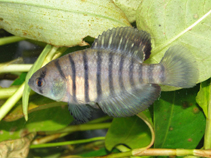| Family: |
Rivulidae (Rivulines), subfamily: Cynolebiinae |
| Max. size: |
5.8 cm TL (male/unsexed); max.weight: 2.6 g |
| Environment: |
benthopelagic; freshwater, non-migratory |
| Distribution: |
South America: inner drainages between laguna dos Patos and lagoa Mirim, southern Brazil. |
| Diagnosis: |
Dorsal spines (total): 0-0; Dorsal soft rays (total): 16-23; Anal spines: 0-0; Anal soft rays: 18-26; Vertebrae: 27-30. Two apomorphic color patterns, body bright gray with dark gray to black stripes in males (versus light gray or no stripes) and a vertically paired black blotch on caudal peduncle of juveniles and females (versus small spots irregularly arranged, or a single round dorsally positioned spot, or no spots on caudal peduncle). Males with light blue stripes parallel to rays on the basal half of unpaired fins and a black blotch anteriorly bordered by a narrow blue line on posterior portion of dorsal and anal fins. Scales on longitudinal series 26-28, supraorbital neuromasts 16-19, pharyngobranchial teeth 2-5. Dorsal fin origin anterior to anal fin origin in females. Caudal fin rounded. |
| Biology: |
|
| IUCN Red List Status: |
Endangered (EN); Date assessed: 07 November 2018 (B1ab(ii,iii)) Ref. (130435)
|
| Threat to humans: |
harmless |
Source and more info: www.fishbase.org. For personal, classroom, and other internal use only. Not for publication.
